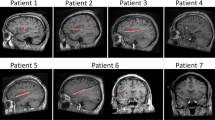Abstract
It is well established that voluntary hyperventilation (HV) slows down electroencephalographic (EEG) rhythms. Little information is available, however, on the effects of HV on cortical responses elicited by sensory stimulation. In the present study, we recorded auditory evoked potentials (AEPs) and magnetic fields (AEFs), and somatosensory evoked magnetic fields (SEFs) from healthy subjects before, during, and after a 3- to 5-min period of voluntary HV. The effectiveness of HV was verified by measuring the end-tidal CO2 levels. Long-latency (100–200 ms) AEPs and long-latency AEFs originating at the supratemporal auditory cortex, as well as long-latency SEFs from the primary somatosensory cortex (SI) and from the opercular somatosensory cortex (OC), were all reduced during HV. The short-latency SEFs from SI were clearly less modified, there being, however, a slight reduction of the earliest cortical excitatory response, the N20m deflection. A middle-latency SEF deflection from SI at about 60 ms (P60 m) was slightly increased. For AEFs and SEFs, the center-of-gravity locations of the activated neuronal populations were not changed during HV. All amplitude changes returned to baseline levels within 10 min after the end of HV. The AEPs were not altered when the subjects breathed 5% CO2 in air in a hyperventilation-like manner, which prevented the development of hypocapnia. We conclude that moderate HV suppresses long-latency evoked responses from the primary projection cortices, while the early responses are less reduced. The reduction of long-latency responses is probably mediated by hypocapnia rather than by other nonspecific effects of HV. It is suggested that increased neuronal excitability caused by HV-induced hypocapnia leads to spontaneous and/or asynchronous firing of cortical neurones, which in turn reduces stimulus-locked synaptic events.
Similar content being viewed by others
Author information
Authors and Affiliations
Additional information
Received: 14 October 1997 / Accepted: 28 October 1998
Rights and permissions
About this article
Cite this article
Huttunen, J., Tolvanen, H., Heinonen, E. et al. Effects of voluntary hyperventilation on cortical sensory responses Electroencephalographic and magnetoencephalographic studies. Exp Brain Res 125, 248–254 (1999). https://doi.org/10.1007/s002210050680
Issue Date:
DOI: https://doi.org/10.1007/s002210050680




